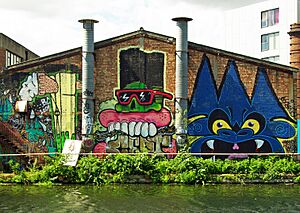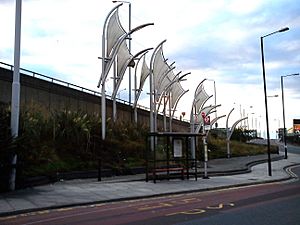Fish Island, London facts for kids
Quick facts for kids Fish Island |
|
|---|---|
 View down Dace Road, Fish Island, with the London Stadium, over the River Lea, in the distance. |
|
| OS grid reference | TQ372841 |
| • Charing Cross | 4.5 mi (7.2 km) SW |
| London borough | |
| Ceremonial county | Greater London |
| Region | |
| Country | England |
| Sovereign state | United Kingdom |
| Post town | LONDON |
| Postcode district | E3, E20 |
| Dialling code | 020 |
| Police | Metropolitan |
| Fire | London |
| Ambulance | London |
| EU Parliament | London |
| UK Parliament |
|
| London Assembly | |
Fish Island is a cool area in east London, England. It's part of the London Borough of Tower Hamlets. Even though it's called Fish Island, it's actually not a real island!
This area is special because it's a "conservation area." This means many of its old buildings are important. They show us what Britain's factories and industries were like long ago.
Recently, Fish Island has been changing a lot. New buildings and homes have been built since 2016. Some people even call it "the new Shoreditch." This is because Shoreditch also changed from an old industrial area to a trendy, modern place.
Fish Island is very close to Hackney Wick. They are so similar that people sometimes think Fish Island is part of Hackney Wick. But they are actually in different parts of London!
Contents
Where is Fish Island?
Fish Island is right next to the River Lea. It also borders the Queen Elizabeth Olympic Park to the east. This is where the 2012 London Olympics were held!
To the west, the A12 road separates Fish Island from Bow. The southern edge of Fish Island is where the A12 road, the River Lea, and train tracks meet.
If you go north, Fish Island goes past the Hertford Union Canal. It then reaches the border with the London Borough of Hackney. This is near the Hackney Wick railway station.
The part of the Olympic Park that is in Tower Hamlets is also seen as part of Fish Island. This makes Fish Island the most north-eastern part of the borough.
Fish Island's Story
Ancient Times
People have lived in the Fish Island area for a very long time. Maybe even since pre-historic times! But we don't have much proof from before the Roman period.
However, we have lots of proof from the Roman times. We don't know exactly what the Roman settlements were like. But people lived here until the 4th or 5th century. Archaeologists found many Roman pots, coins, and even old burial sites. They also found lots of animal bones, especially from cows.
An important Roman road called Pye Road went through this area. This road connected London to Colchester. It probably crossed the River Lea right where Fish Island is today.
After the Romans left, we don't know much about the local settlements. In 1086, a famous book called the Domesday Book mentioned the wider area as Old Ford. It was part of the Manor of Stepney for a long time.
The old Roman road and river crossing eventually broke down. But this area stayed the main way to cross between London and Essex. This was true until a stone bridge was built further downstream in the early 12th century.
There isn't much information about Fish Island from the medieval and post-medieval times. The first map of the area, from 1665, shows it as mostly empty marshland. Only a few people lived there.
Becoming Industrial
In the late 1700s and early 1800s, things started to change. New canals like the Hackney Cut and the Hertford Union Canal were dug. Also, train lines were built through the area. These changes turned Fish Island from a quiet countryside into a busy industrial place.
One of the oldest factories, Crown Wharf, started in 1853. It made wallpaper. Then an ironworks was built next door. Factories that used materials like crude oil and coal tar also opened along the Hertford Union Canal. These factories then made things like printing ink, rubber, and even products for dry cleaning.
The canals and waterways were super important. They helped move raw materials to the factories. They also moved finished products to the docks. At one point, Fish Island was London's biggest industrial area by the water!
In 1865, a large piece of land was bought to build a new gasworks. But the company decided to build it somewhere else. So, the land was sold to another company. They built a "factory town" instead. This town had small houses, multi-storey factories, and new roads.
These new roads were named after fresh water fish. Names like Dace, Bream, and Roach were used. Since locals already called the area "the Island," it soon became known as Fish Island.
By the late 1800s, Fish Island was full of many different factories. The work was often dangerous or smelly. About 6,000 people lived there. Most were workers and their families. Even though living conditions got a bit better later, many people in Fish Island lived in poverty.
During World War II, Fish Island was badly bombed. Many buildings were completely destroyed or seriously damaged.
After the War and New Changes
After the war, Fish Island changed a lot. Many factories closed or changed what they did. The area became mostly for things like waste disposal, timber yards, and warehouses. Many people moved away. Houses were torn down or turned into industrial spaces. By the 1970s, Fish Island was mostly just factories and warehouses.
In the 1990s, something new happened. Many creative industries and artists started moving in. They turned old warehouses into art studios or homes. It's said that in the 1990s, Fish Island had more artists than almost anywhere else in Europe! Fish Island and Hackney Wick became famous for their art scene.
In the early 2000s, Fish Island got a lot of attention. This was because it was very close to the Queen Elizabeth Olympic Park. This park was built for the London 2012 Olympics. Local councils decided Fish Island and Hackney Wick were important areas to improve.
So, many new homes and buildings were constructed. More are still being built today. These changes made living costs and property prices go up. This is why people compare it to Shoreditch. In 2016, a newspaper even called Fish Island "the new Shoreditch."
Arts and Culture

Fish Island has a long history of being a home for artists. In 2009, it was found to have one of the highest numbers of artists, designers, and craftspeople in Europe. There were about 600 artist studios in the area!
The London Centre for Book Arts has been in the Britannia Works building since 2012. This center helps people learn about making books and publishing. It has tools for printing, binding, and publishing.
The Heath Studio opened in 2018. It's a great place for art, photography, fashion, and film projects. This studio is in the historic Iron Works building, which dates back to 1853!
In 2014, a project called Fish Island Labs started. It helped 40 to 50 young artists and tech people share a low-cost workspace. They got help and advice for ten months.
Also, the TV show The Big Breakfast on Channel 4 was filmed at the Lock Keeper's Cottage in Fish Island. It was broadcast from there from 1992 to 2002.
Nearby Places
- Bow
- Hackney Wick
- Queen Elizabeth Olympic Park
- Stratford
- Old Ford
- Victoria Park



